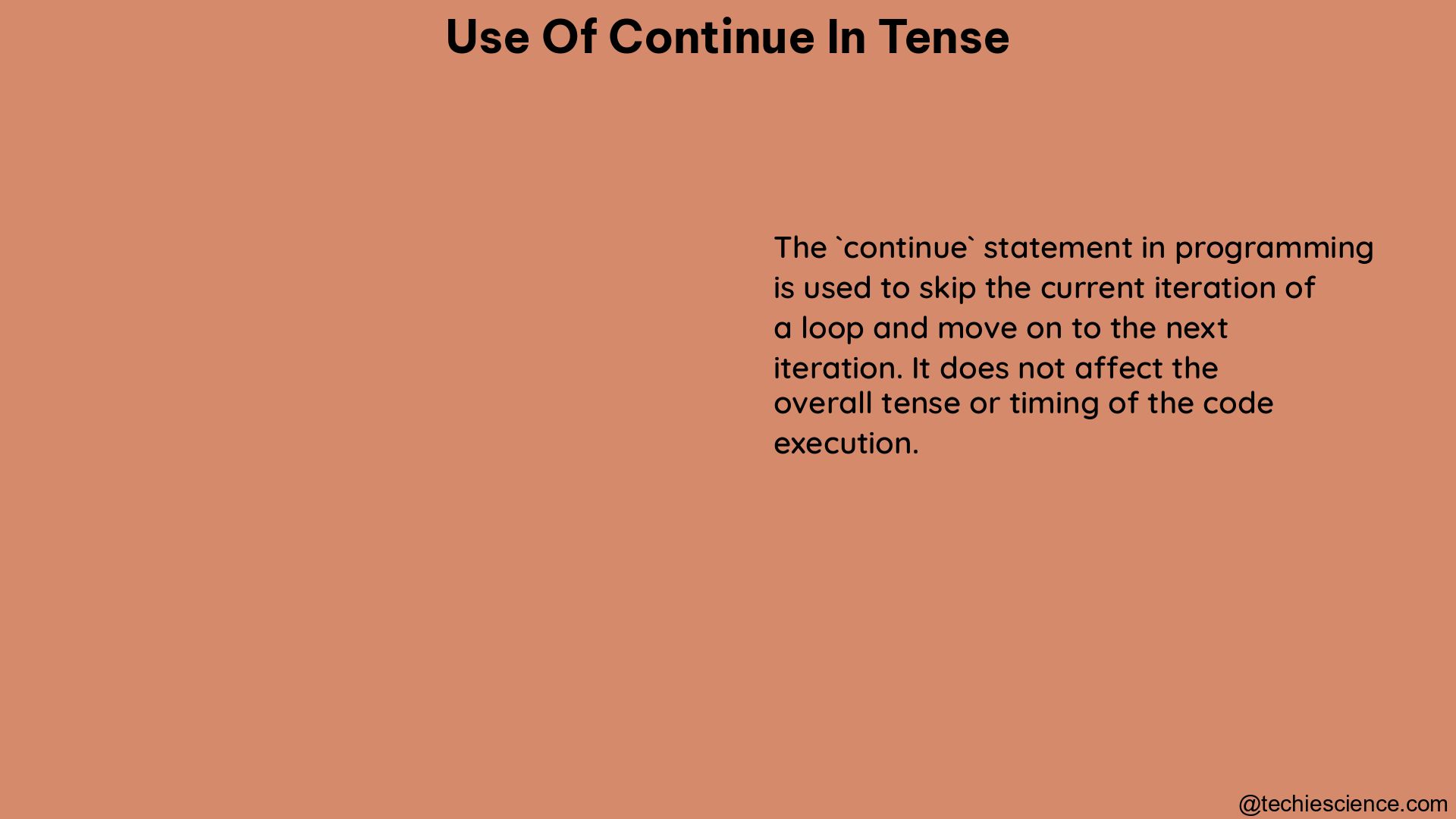The use of “continue” in various tenses is crucial for effective communication in English. This comprehensive guide will provide you with a deep understanding of how to use “continue” accurately in different tense forms, along with detailed explanations and examples to help you become a proficient English speaker.
1. Present Tense
Simple Present
The simple present tense is used to express general truths, habits, or regular actions. When using “continue” in the simple present, the structure is “continue to + verb.”
Examples:
– I continue to work on my project.
– You continue to study for your exam.
– He/She/It continues to learn new skills.
– We continue to support the cause.
– You continue to help others.
– They continue to innovate.
Present Continuous
The present continuous tense is used to describe actions happening at the moment of speaking. The structure for using “continue” in the present continuous is “am/is/are continuing to + verb.”
Examples:
– I am continuing my research.
– You are continuing your education.
– He/She/It is continuing to grow.
– We are continuing our efforts.
– You are continuing to improve.
– They are continuing to succeed.
2. Past Tense

Simple Past
The simple past tense is used to express completed actions in the past. When using “continue” in the simple past, the structure is “continued to + verb.”
Examples:
– I continued my studies.
– You continued to work.
– He/She/It continued to help.
– We continued our journey.
– You continued to learn.
– They continued to thrive.
Past Continuous
The past continuous tense is used to describe actions in progress at a specific time in the past. The structure for using “continue” in the past continuous is “was/were continuing to + verb.”
Examples:
– I was continuing my project.
– You were continuing your training.
– He/She/It was continuing to grow.
– We were continuing our efforts.
– You were continuing to improve.
– They were continuing to succeed.
3. Past Perfect Tense
Past Perfect
The past perfect tense is used to express actions that were completed before another action in the past. The structure for using “continue” in the past perfect is “had continued to + verb.”
Examples:
– I had continued my education.
– You had continued your job.
– He/She/It had continued to help.
– We had continued our journey.
– You had continued to learn.
– They had continued to thrive.
Past Perfect Continuous
The past perfect continuous tense is used to describe actions that started before another action in the past and continued up to that point. The structure for using “continue” in the past perfect continuous is “had been continuing to + verb.”
Examples:
– I had been continuing my research.
– You had been continuing your education.
– He/She/It had been continuing to grow.
– We had been continuing our efforts.
– You had been continuing to improve.
– They had been continuing to succeed.
4. Future Tense
Simple Future
The simple future tense is used to express actions that will happen in the future. When using “continue” in the simple future, the structure is “will continue to + verb.”
Examples:
– I will continue my project.
– You will continue your studies.
– He/She/It will continue to help.
– We will continue our journey.
– You will continue to learn.
– They will continue to thrive.
Future Continuous
The future continuous tense is used to describe actions that will be in progress at a specific time in the future. The structure for using “continue” in the future continuous is “will be continuing to + verb.”
Examples:
– I will be continuing my research.
– You will be continuing your education.
– He/She/It will be continuing to grow.
– We will be continuing our efforts.
– You will be continuing to improve.
– They will be continuing to succeed.
5. Future Perfect Tense
Future Perfect
The future perfect tense is used to express actions that will be completed before another action in the future. The structure for using “continue” in the future perfect is “will have continued to + verb.”
Examples:
– I will have continued my education.
– You will have continued your job.
– He/She/It will have continued to help.
– We will have continued our journey.
– You will have continued to learn.
– They will have continued to thrive.
Future Perfect Continuous
The future perfect continuous tense is used to describe actions that will start before another action in the future and continue up to that point. The structure for using “continue” in the future perfect continuous is “will have been continuing to + verb.”
Examples:
– I will have been continuing my research.
– You will have been continuing your education.
– He/She/It will have been continuing to grow.
– We will have been continuing our efforts.
– You will have been continuing to improve.
– They will have been continuing to succeed.
Key Points
- The verb “continue” can be used in both simple and continuous tenses.
- In simple tenses, the structure is “continue to + verb,” while in continuous tenses, the structure is “am/is/are/was/were/will be continuing to + verb.”
- The choice of tense depends on the context and the time frame being referred to.
Examples
- Simple Present: People continue to use cheques.
- Present Continuous: People are continuing to use cheques.
- Simple Past: People continued to use cheques.
- Past Continuous: People were continuing to use cheques.
- Simple Future: People will continue to use cheques.
- Future Continuous: People will be continuing to use cheques.
References
- Bab.la. (n.d.). How to conjugate “to continue” in English? Retrieved from https://en.bab.la/conjugation/english/continue
- EC English. (2013, December 26). Continuous Tenses. Retrieved from https://www.ecenglish.com/learnenglish/lessons/continuous-tenses
- Stack Exchange. (2013, September 15). Difference between “continue to” and “are continuing to”. Retrieved from https://ell.stackexchange.com/questions/10332/difference-between-continue-to-and-are-continuing-to

Hi…. I am Goutam Datta. I have completed a double M. A. in English and B. Ed. I am a creative writer. Currently, I am a part of the LambdaGeeks.